Second Hair Transplant: Can You Have Multiple Surgeries?
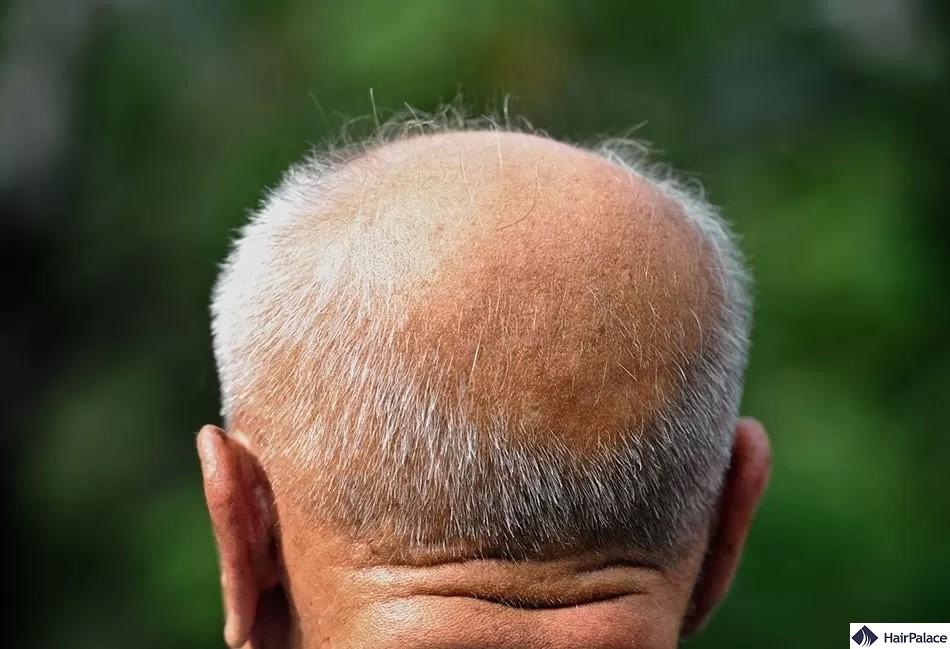
Technically, you can have as many hair transplants as you like, but the number is affected by the quality of the donor area and the number of hairs extracted in each procedure.
In this post, we will take a look at when a second procedure is necessary after your first hair transplant.
We’ll explore how much time one has to wait in between the sessions, and how second hair transplants affect the donor area.
- When do you need a second hair transplant?
- How long should you wait before having a second hair transplant?
- How would the repeated surgeries affect the donor area?
- Second hair transplant before and after
- Donor area after hair transplant
- How to avoid needing a second or third hair transplant
- Where to get your second hair transplant
- Conclusion
When do you need a second hair transplant to add density?
Roughly 5000 hairs can be extracted in a one-day hair transplant operation.
This number ensures that the extracted grafts do not spend too much time outside the body and prevents you from getting a second hair transplant scar.
In addition, it keeps the amount of necessary medication within safe limits and allows greater patient comfort during the procedure.
Depending on the severity of the hair loss, one hair transplant procedure might not be enough.
In such cases, a second hair transplant is needed to achieve the desired coverage.
Hair loss by ageing
A second hair transplant procedure can also be necessary years after the first session if the hair loss progresses.
Though hair loss is in part hereditary, there are a large number of factors that may affect it.
Among others, hormonal imbalance, stress, certain medications, and our lifestyle can affect the hair loss process.
While there are cases when it is slow and gradual, there are others when the hair loss is more periodic.
As hair loss is rather unpredictable, surgeons aim to achieve the best possible result with the session at hand while preserving the donor area for possible treatments in the future.
How long should you wait before having a second hair transplant?
One may enjoy the result of a single hair transplant for years before the natural hair loss process starts again.
As such, 3-5-10 years might pass before the second hair transplant becomes necessary.
However, due to the severity of the hair loss or continued thinning, a follow-up procedure might be necessary earlier.
In these cases, your hair transplant clinic will likely recommend waiting around 15 months between hair transplant procedures.
The two main factors affecting the exact length of the period are:
1. The recipient area
It is best to wait at least a year if you plan to increase the density in the same area, or if you want to address a section that reaches into the previously implanted area.
Firstly, this allows the surgeon to see the previously implanted hairs, ensuring that they do not damage hairs yet to grow out.
Secondly, this way the surgeon can also take into consideration the overall look and plan the distribution better.
2. The hair loss
If the hair loss restarted after the surgery, you will have to wait until it stops again.
This will help to find the optimal distribution of the hairs during the second surgery providing better results in the long run.
What would be the effect on your hair transplant donor area?
The number of hairs we can transplant – and the number of surgeries we can carry out – varies.
The options are always determined by the density and size of the donor area.
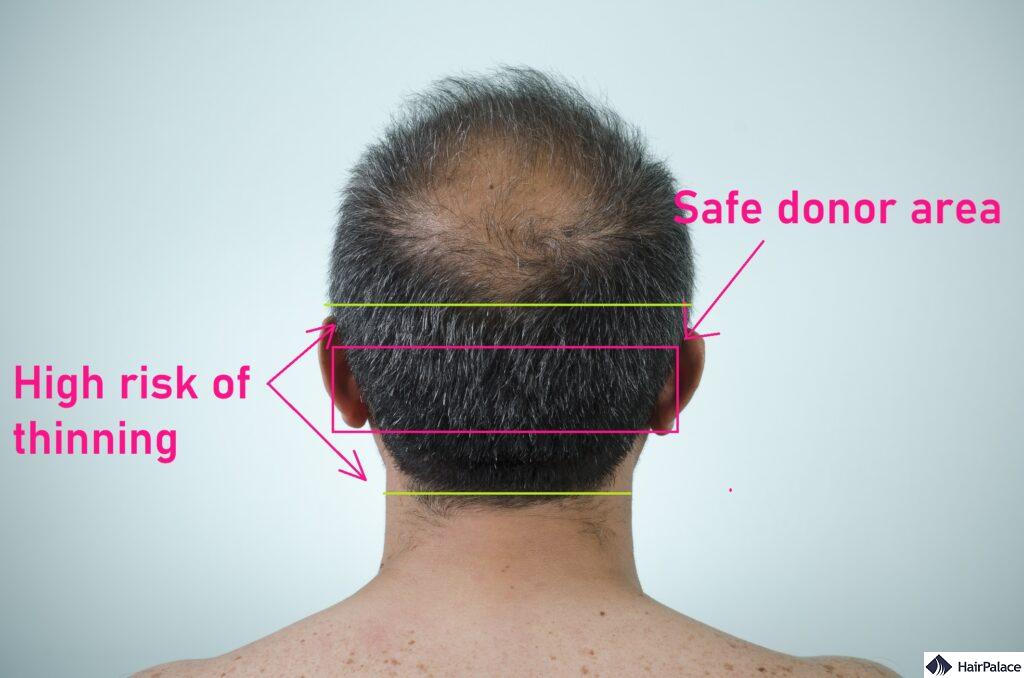
In each case, the donor area has a certain limit; a finite number of hairs can be extracted from it.
Each hair restoration surgery will lower the number of hairs in the donor zone and thus, its density.
This is one of the main reasons why you must choose your surgeon and the hair transplant method carefully.
Higher success rates mean not only that the transplanted hairs grow out in higher numbers. It also means that fewer extracted hairs go to ‘waste’.
With the right technique in the right hands, overharvesting the donor area can be avoided, and the doctors take out only as many hairs as necessary for a good result.
With the FUE2 SafeSystem method we use, around 95% of the transplanted hairs grow out after the surgery.
Naturally, proper aftercare is also crucial to realise this success rate and maximise your second hair transplant results.
One of the best features of the FUE2 SafeSystem is that it does not leave any visible scars even after multiple hair transplant correction surgeries.
Second hair transplant before and after
You can see David’s example below and how his three surgeries gradually affected the donor area:
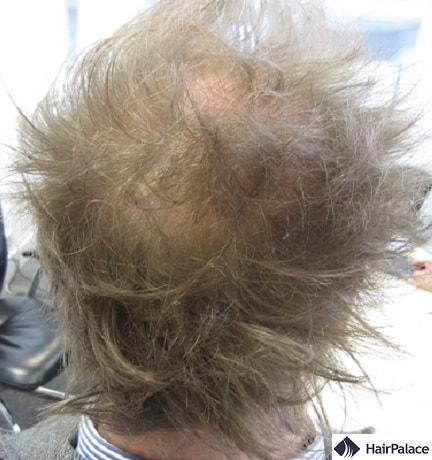
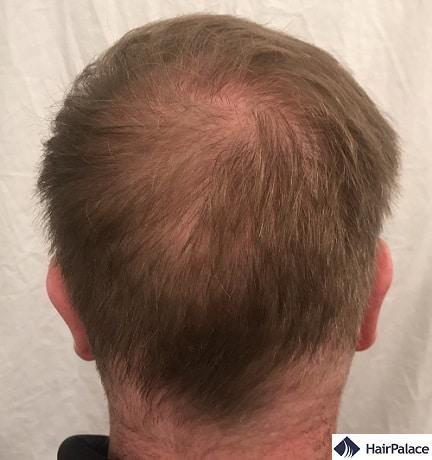
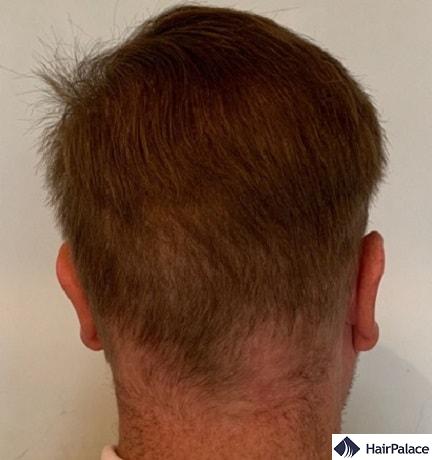
Donor area after hair transplant
Dariusz serves as another great example of how the donor area recovers after a hair transplant.
As you can see, the results are seamless, and it’s nearly impossible to tell that he even had surgery in the first place.
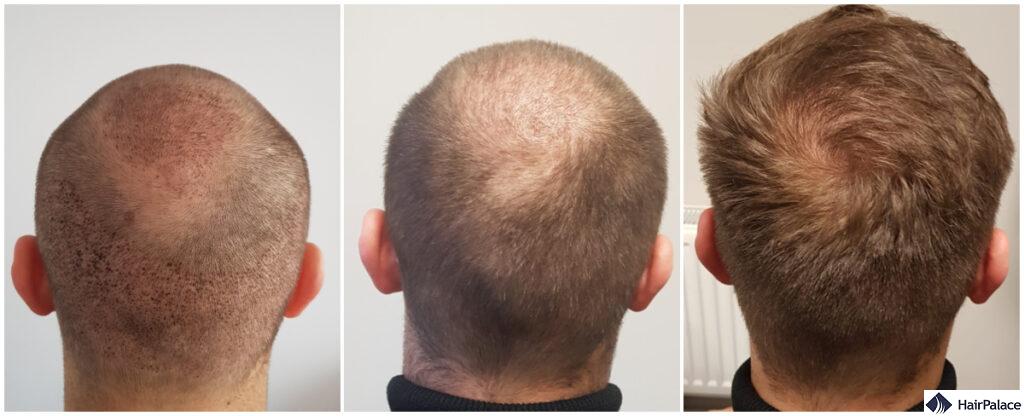
How to avoid needing a second or third hair transplant procedure
Unfortunately, there’s no guaranteed way to completely avoid a second or third hair transplant.
However, many individuals can fully restore their hair with just one well-executed procedure.
The key to minimising the likelihood of additional surgeries is timing.
It’s best to wait until your pattern of hair loss has stabilised before undergoing a transplant, ensuring that future thinning doesn’t undermine your results.
Using medications such as minoxidil or finasteride in the early stages of hair loss can significantly slow, or even halt, its progression, helping preserve existing hair.
When you do decide to move forward with surgery, choosing an experienced and qualified specialist is crucial.
A well-planned transplant with proper graft density and natural placement can deliver lasting, natural-looking results, often eliminating the need for future procedures.
Where to get your second hair transplant
A hair transplant in Hungary offers an excellent alternative that allows you to save money without compromising on quality.
While undergoing the procedure abroad does require a bit more preparation, a hair transplant in Hungary can easily save you several thousand pounds compared to treatment in the UK.
Thanks to convenient transport connections and the relatively short distance between the two countries, travelling to Hungary is generally straightforward.
If you’re looking for a high-quality hair transplant at a fair price, Hungary is the ideal choice.
Why choose HairPalace?
With HairPalace, you get premium results without the premium price tag.
Our surgeons have over 10 years of experience and have successfully performed more than 6,000 procedures.
We specialise in hair transplants for the crown area, receding hairlines, and restoring natural hair density using the minimally invasive FUE technique.
Our doctors are so confident in their work that every procedure comes with a written guarantee.
From your free initial consultation to your final follow-up, our team will ensure a smooth and stress-free experience.
We’ll create a personalised treatment plan tailored to your needs.
Book your free, no-obligation consultation today! Speak with one of our doctors and discover how we can help you restore your hair along with your confidence.
Conclusion
Hair transplant surgery offers a permanent solution to thinning hair.
However, in most cases reaching or maintaining a good result is a process. As such, it might require a second hair transplant surgery over the years.
This can be done with the same method, or you may get an artificial hair implant.
Nevertheless, within the limits of the donor area, a traditional hair transplant can be repeated 2-4 times in one’s lifetime.
It is vital to always carry out the hair transplant surgery at hand in a way that offers the best result in the current condition while preserving the donor area as much as possible.
Second Hair Transplant FAQ
A second procedure does not necessarily take longer to grow compared to the first one. The growth rate after a hair transplant typically depends on individual healing processes and the overall health of the hair follicles, rather than the number of transplants performed. However, the condition of the scalp and the availability of healthy donor hair can affect the outcome of subsequent transplants.
Additional hair transplants may be necessary or desired in cases where the patient seeks increased density or coverage after the first transplant. It’s also an option for those who experience progressive hair loss after their first transplant and wish to address newly thinned or bald areas.
It is possible to run out of donor hair if the available hair in the donor area (usually the back and sides of the head) becomes too thin or depleted. This depends on the extent of the initial harvesting, the quality of the donor area, and the individual’s hair density.
The number of grafts for a second hair transplant depends on the remaining donor hair, scalp elasticity, and the surgeon’s assessment. Typically, it ranges from 2,000 to 4,000 grafts, but it varies based on individual circumstances.
A second hair transplant is typically done to add density or cover new areas of hair loss. The surgeon uses remaining donor hair (usually from the back/sides of the scalp) to extract grafts. The procedure follows the same steps as the first transplant (e.g., FUE or FUT).
The cost depends on the number of grafts needed and the clinic’s pricing, typically ranging from £3,000 to £15,000. It’s usually similar in cost to the first transplant. However, you can often find much better deals abroad.
If donor hair is insufficient, a second transplant may not be possible. Alternatives include scalp micropigmentation, hair systems, or medication to maintain existing hair. A consultation with a specialist is needed to assess your options.
Last medically reviewed on June 27th, 2025
- Mysore, Venkatram; Kumaresan, Muthuvel1,; Garg, Anil2; Dua, Aman3; Venkatram, Aniketh1; Dua, Kapil3; Singh, Mayank4; Madura, C5; Chandran, Ram6; Rajput, Rajendra Singh7; Sattur, Sandeep8; Singh, Sukhbir9. Hair Transplant Practice Guidelines. Journal of Cutaneous and Aesthetic Surgery 14(3):p 265-284, Jul–Sep 2021. | DOI: 10.4103/JCAS.JCAS_104_20https://journals.lww.com/jcas/Abstract/2021/14030/Hair_Transplant_Practice_Guidelines.1.aspx
- Dua, Aman; Dua, Kapil1. Follicular Unit Extraction Hair Transplant. Journal of Cutaneous and Aesthetic Surgery 3(2):p 76-81, May–Aug 2010. | DOI: 10.4103/0974-2077.69015https://journals.lww.com/jcas/Fulltext/2010/03020/Follicular_Unit_Extraction_Hair_Transplant.3.aspx
- Venkataram, Aniketh; Mysore, Venkataram. Logic of Hair Transplantation. Journal of Cutaneous and Aesthetic Surgery 11(4):p 169-172, Oct–Dec 2018. | DOI: 10.4103/JCAS.JCAS_183_18https://journals.lww.com/jcas/Fulltext/2018/11040/Logic_of_Hair_Transplantation.3.aspx
- Marwah, Manjot K.; Mysore, Venkataram1. Recipient Area. Journal of Cutaneous and Aesthetic Surgery 11(4):p 202-210, Oct–Dec 2018. | DOI: 10.4103/JCAS.JCAS_124_18https://journals.lww.com/jcas/Fulltext/2018/11040/Recipient_Area.8.aspx
- Dua, Aman; Dua, Kapil1. Follicular Unit Extraction Hair Transplant. Journal of Cutaneous and Aesthetic Surgery 3(2):p 76-81, May–Aug 2010. | DOI: 10.4103/0974-2077.69015https://journals.lww.com/jcas/Fulltext/2010/03020/Follicular_Unit_Extraction_Hair_Transplant.3.aspx
- Chouhan, Kavish; Kota, Rahulkrishna S.; Kumar, Amrendra; Gupta, Jyoti. Assessment of Safe Donor Zone of Scalp and Beard for Follicular Unit Extraction in Indian Men: A Study of 580 Cases. Journal of Cutaneous and Aesthetic Surgery 12(1):p 31-35, Jan–Mar 2019. | DOI: 10.4103/JCAS.JCAS_142_18https://journals.lww.com/jcas/Fulltext/2019/12010/Assessment_of_Safe_Donor_Zone_of_Scalp_and_Beard.5.aspx


